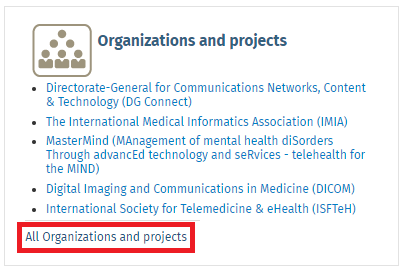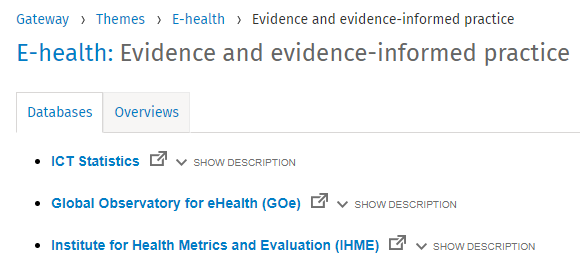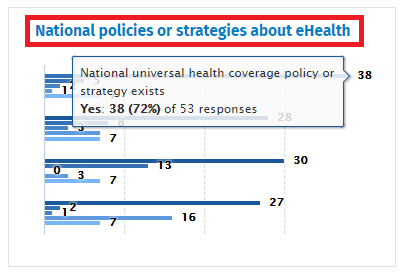This tutorial gives an introduction to the different elements of themes: Visualizations and indicators, Organizations and projects, Evidence and evidence-informed practice, Policy & Analysis, and Tools & Methods.
Note: Russian subtitles are available for the video.
1. Themes are organized and curated for the Gateway, making it easier to find the most relevant information. There are currently 18 themes in the Gateway and the information is organized using the same hierarchical structure where themes are at the top level.
2. To show the different elements, the E-health theme is used as an example. E-health involves a broad group of activities that use electronic means to deliver health-related information, resources and services: it is the use of information and communication technologies (ICT) for health.
3. Open European Health Information Gateway in your browser
4. Click on the E-health theme.
5. Themes have two different types of elements: Qualitative and quantitative information.
a. Qualitative information is structured in a way, so each theme has groups for Organizations and projects, Evidence and evidence-informed practice, Policy & Analysis, and Tools & Methods.
b. Quantitative information, on the other hand, consists of Visualizations and indicators.
6. Click on All Organizations and projects to look at Organizations and projects.

7. The Organizations and projects element has references to Organizations and projects which are related to E-health in European region. Organizations and projects are structured depending on their type, and for E-health are divided into three categories: Intergovernmental organizations and national government bodies, Non-State Actors, and Projects.

a. Organizations are structured in a hierarchy. For example, the European Standards Organizations contains three organizations: European Committee for Electrotechnical Standardization, The European Committee for Standardization, and The European Telecommunications Standards Institute.

Click SHOW DESCRIPTION to see further details and click on the title to go to that Organization or project.
b. The next category in Organizations and projects for E-health is Non-State Actors and it only contains NGOs.
c. The third and last category for Organizations and projects for E-health is Projects. It contains a list of projects that are relevant for E-health in the European region.
8. Click on E-health in the breadcrumbs to go back to the Theme page for E-health.

9. Click All Evidence and evidence-informed practice to open Evidence and evidence-informed practice. The layout for Evidence and evidence-informed practice is similar to Organizations and projects. There are tabs for each category – Databases and Overviews, and the list of resources is shown below.

a. Databases contains a list of relevant databases.
b. Overviews contains a list of resources.
10. Click on E-health breadcrumb to go back to the Theme page for E-health, and click on All Policy & Analysis to open Policy & Analysis.
a. Policy & Analysis contains diverse types of policies, and frameworks, including the EU’s eHealth policy, and a national eHealth strategy for Ireland.
b. Relevant analytical resources on E-health are listed in the Analysis tab.
11. Click on E-health breadcrumb to go back to the Theme page for E-health, and click on All Tools & Methods to open the Tools & Methods element of the E-health theme. Tools & Methods is arranged into four categories: Monitoring, Policy support, Capacity-building, and Knowledge exchange.
a. The Monitoring category contains tools used in E-health, such as District Health Information Software 2 which is an information system to collect, manage and explore data. Also, there is information on the Global Observatory for eHealth series, which are publications on various aspects related to E-health.
b. Policy support contains resources and evidence that cover the various stages of health policy-making.
c. Capacity-building lists resources for increasing knowledge about E-health. Among the resources are: A network to support developing and sustaining school health promotion, and interactive courses targeted at physicians.
d. Knowledge exchange provides links to various centers, platforms and networks for the exchange of knowledge.
12. Click on E-health breadcrumb to go back to the Theme page for E-health. The E-health theme page features four visualizations. More details appear when you hover the mouse cursor over the miniatures. Click on the title of the visualization to open the visualization.

13. Click on E-health breadcrumb to go back to the Theme page for E-health. Some Visualizations and indicators are shown on the Theme page for E-health, and all of them are available by clicking All Visualizations and indicators.